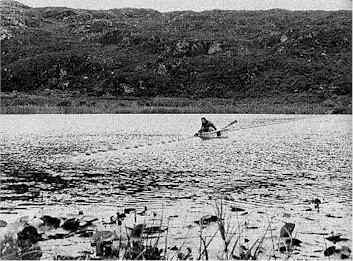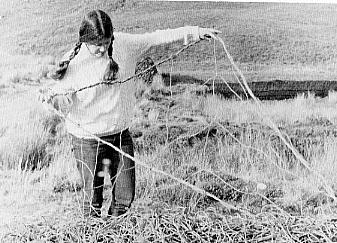|
Expeditions
Historically there are a number of references of strange water
animals having been captured or even killed in Ireland.
Unfortunately, in none of these recorded instances was the body
preserved for any formal examination. This was mostly likely due
to the fact that in such areas were the creatures were found the locals
had some degree of familiarity with them and therefore did not recognize
the greater significance such a specimen would have held for
science.
It wasn't until the latter half of the 20th century that efforts of a
scientific nature were launched in hopes of properly identifying the
very creatures allegedly responsible for the lake monster phenomena in
Ireland.
1968
Connemara
During the spring of 1968
various members of the Loch Ness Investigation Bureau gathered in
Clifden for what would become the first of two attempts at capturing an
Irish lough monster. On hand was Dr. Roy P. Mackal, F.W. Holiday
and fellow Bureau member Lionel Leslie who'd been actively investigating
reports in western Ireland concurrent to his colleagues efforts at Loch
Ness. Based upon the testimonies gathered by Leslie, the Bureau
became confident that a species similar, if not identical, to the ones
pursued in Loch Ness could be found within the significantly smaller bog
lakes of Connemara. Attempting to acquire a specimen in loughs a
mere fraction the size of Ness naturally appeared far more pragmatic to
the team.
With a combined arsenal consisting of a fish-stunner,
echo-sound technology, mountable cine cameras, a Greener harpoon gun and
nets that could expand the width of a small lake, the team originally
choose the glacial-carved Lough Shanakeever as their primary hunting
grounds. Sightings in Shanakeever dated back at least 30
years based upon what reports Lionel Leslie had collected up to that
point.
Leslie had obtained the
impression from locals that the animals, referred to by some as
"horse-eels", were thought to burrow themselves into the mud from which
they would lay dormant for considerable durations of time. In
light of this local lore one team member made preparations to have
gelignite detonated along the shore to function as something of a rude
wake up call for any slumbering peistes. Such a proposal may sound a tad extreme, but a previous attempt
involving explosives had yielded encouraging results. In 1965
Leslie set off 7 lbs of gelignite along the shore of Lough Fadda after
becoming familiar with the 1954 sighting. It was recorded that ten
seconds proceeding the blast, a long black object broke the surface and
began violently thrashing about. Cameras were on hand but
apparently failed to capture the activity before it subsided.
Hoping to repeat what might have been previous success, the team was
prepared (and legally licensed) to deploy nets and obtain a
tissue-sample via a harpoon should anything of interest surface after
the blast. Another strategy was to deploy something of a large
improvised eel-trap into the lake which was to be baited with fish offal
and small eels. The trap was to remain for the summer season while
being frequently checked and re-baited. Also on the agenda was for
a net to be stretched across the lake as strategic disturbances were
deployed in hopes of driving any possible horse-eels toward
entanglement.
Lough Shanakeever had been chosen
for its workable size and the relative consistency of sightings.
The previous four summers had all yielded reports. However, at the
last moment, plans were altered when word came through that a sighting
that had taken place only months prior in the even smaller Lough
Nahooin. In some ways the lake's lack of size seemed to push
limits on the very definition of the word "lake" as it was only an
estimated 250 yards in length by 150 yards in width. Initially the
dimensions were viewed with both optimism and skepticism. Sensing
opportunity at hand, F.W. Holiday made the comment, "If one's in here,
then it's ours".
Despite the creative strategies that had been
set for trial in Shanakeever, efforts in Nahooin were limited only to
placing a net across the lake. Holiday wrote that on one
particular morning, several of the net's buoys had sunken from
view. What had caused them to submerge was something of a
mystery. Keeping alternative explanations in mind, Holiday
pondered if a peiste had challenged the blockade during the night.
Aside from this indeterminable possibility there was no indication of a
lake creature residing in Lough Nahooin for the remaining short amount
of time LNIB was present. The lake's dimensions proved too
unsettling for most participants, especially Dr. Mackal who wrote
"...not even one substantial animal could have more than a transient
relation with this little pond, even if one assumed maximum of possible
food sources." He continued that it was possible the animals
were semi-aquatic as some reports suggested, and therefore at least
partially transitory.
LNIB may have failed in
collecting a specimen but their efforts weren't entirely in vain.
During the course of their stay additional witnesses were found and
valuable testimony was subsequently recorded. The team came to
learn of a local tradition pertaining to an incident from the previous
century where a horse-eel had become lodged within a culvert from which
it eventually died within. During a visit to the site Dr. Mackal
took a measurement of the culvert opening and concluded the animal must
have had a diameter of around 17 inches.
It's intriguing that LNIB came
with the mindset that they were dealing with stationary creatures
inhabiting such relatively tiny bodies of water. Even if there was
a creature taking active and continual residency in Lough Nahooin,
surely it would have to leave or at least be joined by an outside peiste
for reproduction. (Unless these oddities come equipped for
parthenogenesis upon everything else.)
Sources:
The
Monsters of Loch Ness by Dr. Roy P. Mackal. Chapter
III "Ireland 1968" (p.37)
The Dragon & the Disc by F. W.
Holiday. Chapter IV "The Irish-Dragon-Hunt"
(p.48)
1969 Connemara
One year after the Loch Ness
Investigation Bureau's unsuccessful expedition to Ireland, four members
returned to the bog lands of Connemara for yet another round of
effort. This time they planned to take on Lough Shanakeever and
Lough Auna in addition to giving Lough Nahooin another shot. The
team was significantly smaller than the one prior, consisting only of
Ivor Newby, Lionel Leslie, F. W. Holiday and LNIB secretary Holly
Arnold. Efforts were broader however, as nets were placed
simultaneously in all three lakes.

LNIB member Ivor Newby
checking nets in Lough Nahooin. A creature
had been seen in the reeds in the background on the left.
(The Dragon and the Disc; Holiday)
Despite previous
disappointment, Lough Nahooin seemed to once again flaunt its potential
after Lionel Leslie met with a local farmer who'd had a sighting of a
strange creature on the shore of the lake only one month
prior. However, this time the net-wall faced complications.
Persistent rains had swollen Nahooin, creating permissible gaps along
the bottom in areas where the net failed to touch. Additionally,
plans to drag the lake with chains were thwarted due to the abundance of
snagging lilies.

Loch Ness Investigation
Bureau secretary Holly Arnold
unraveling a net with Lough
Shanakeever in the background.
(The
Dragon and the Disc; Holiday)
The three nets were checked
repeatedly and readjusted when needed but at no time did they secure any
unknown creatures. Nonetheless the team was keen on conducting
their own survey of the families and residences along the lakes to
extract what knowledge or experiences they may have had with
horse-eels. Holiday wrote that it seemed over half the population
either had seen a creature or knew of someone close who
had.
The Dragon & the Disc
by F. W. Holiday. Chapter IV "The Irish-Dragon-Hunt"
(p.48)
1982 Lough
Derg
In July of 1982 Lionel Leslie
conducted an expedition of some sort on Lough Derg. Until his
unpublished works are recovered somehow the only details available on
this particular operation are for the most part limited to a letter he'd
submitted with the Irish Times.
(Special thanks to Peter
Costello with sharing this piece from his
archives.)
----------------------------
A LOUGH DERG
MONSTER
Sir, --I am writing to let you know the results of a recent
expedition to Ireland made by American scientists, in which I took
part. These results have now been checked and
analyzed.
The Academy of Applied Science, Boston, a
nonprofit-making establishment formed for the purpose of scientific
research and education, carried out a side-scan sonar survey of Lough
Derg on the Shannon early October, 1982. The objects were firstly
to examine topography bottom; secondly, to collect information of
wildlife; and thirdly, search for any signs of large creatures reported
recently.
The
expedition was based at Mounshannon and plans (to?) return in 1983 to
carry out underwater strobe camera photograph. In the interests of
science, as well as an attraction for tourism, it may be hoped
protective measures will be taken on Lough Derg, similar to those in
force on Lough Ness.
During the operations that were carried out
with a cabin cruiser, we were helped by the information given by a local
witness James Minogne -known affectionately as Jimmy the Crock -who is
remarkably well informed about the lake.
Incidentally, I happen to be an expatriate
from County Monaghan, and hence my interest.
Yours, etc.,
Lionel Leslie
Grasspoint, Isle of Mull,
Argyll.
----------------------------
The "American scientists" no
doubt consisted of Dr. Robert Rines whose perhaps most famous for
attaining the "flipper" photo and other well published underwater images
associated with the Loch Ness
monster.
198(?) Lough
Fadda
A "search" of some sort was
conducted in Lough Fadda during the early 1980s. It at least made
a local paper but as for what it entailed and how many participated;
well, I didn't take any notes on it when I had the chance.
If any readers are familiar with the details
surrounding this event please contact me.
2001 Lough
Ree
In June of 2001 Swedish veteran
serpent-tracker Jan Sundberg of GUST arrived in Athlone to
search for the alleged "Lough Ree Monster". Accompanying him was
Espen Samuelson of Norway and myself, at the time stationed in
Hawaii. My participation was something of a chance event.
Earlier that summer I'd decided to take leave from the military and had
been romancing the idea of returning to Ireland for follow-up
research. By sheer coincidence Jan emailed me to inform that he
was intending on leading an expedition to Lough Ree that very
summer.
The extent of the expedition
centered around frequent excursions out onto semi-secluded spots of the
lake where Jan would then deploy his hydrophone into the water as Espen
and I kept vigilant watch for any unusual activity. The
'operation' was well publicized receiving second page coverage in the
Irish Times and a segment on RTE evening
news. | ![]()